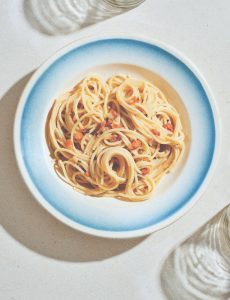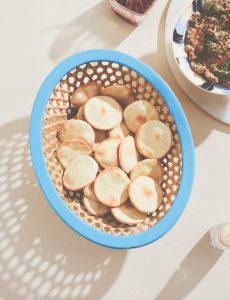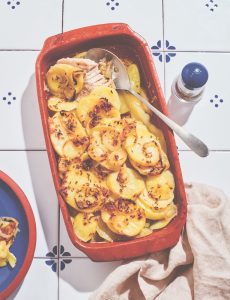As a child I was lucky enough to live, for a few years, in Malta.
The Maltese Islands still hold my happiest childhood memories, and I’ve managed to return for a few visits as an adult.
Malta by Simon Bajada
If you’re also a fan of these honey-coloured islands that are layered – literally – with history, you’ll love this recently published cookbook and gloriously photographed (by the author) travelogue: Malta by Simon Bajada, published by Hardie Grant £26.
Many empires have influenced the Maltese kitchen over the centuries, leaving an alluring blend of Arab, French, Italian and English flavours and techniques. The resulting cuisine is packed with fruits of the sea, flavourful seasonal produce and recipes passed down through the generations, set against a backdrop of dramatic rocky outcrops and spectacular blue water.
About the Book
 Exploring his own family heritage, Simon Bajada captures Maltese food for the home cook. The recipes are enticing, with the influence of multiple cuisines apparent. There are Anchovy Fritters, Sea Urchin Spaghetti and Swordfish Carpaccio, all making delicious use of the island’s proximity to the beautiful Mediterranean Sea. For something more comforting, there is a traditional Rabbit Stew, and Stuffed Artichokes packed with garlic and potato. For those with a sweet tooth there is a decadent Maltese Orange Tart – flavoured with blood orange – and if you prefer coffee after dinner there is a recipe for Maltese Coffee Granita and Whipped Ricotta.
Exploring his own family heritage, Simon Bajada captures Maltese food for the home cook. The recipes are enticing, with the influence of multiple cuisines apparent. There are Anchovy Fritters, Sea Urchin Spaghetti and Swordfish Carpaccio, all making delicious use of the island’s proximity to the beautiful Mediterranean Sea. For something more comforting, there is a traditional Rabbit Stew, and Stuffed Artichokes packed with garlic and potato. For those with a sweet tooth there is a decadent Maltese Orange Tart – flavoured with blood orange – and if you prefer coffee after dinner there is a recipe for Maltese Coffee Granita and Whipped Ricotta.
It’s a virtual trip to the Mediterranean and will bring some rays of sunshine in these dark wintery days. It will also make a fabulous Christmas present for anyone who’s recently visited, or plans to.
This is as much a storybook as it is a cookbook, with the island’s history and landscape lending context to Simon’s recipes.
Here are some recipes to show you what a lovely cookbook this is… the first recipe reminds me of glorious summer days in Sliema, enjoying this dish at the beach cafe:
SPAGETTI RIZZI (Sea Urchin Spaghetti)
Serves 4; Preparation: 10 minutes; Cooking: 15 minutes
“When writing about this dish, in my mind I’m exploring craggy rocks beside the Mediterranean, dodging urchins under foot while Malta’s sun beams down on me. This dish takes you to the seaside. The flavour of the sea penetrates through the pasta – a dish so simple that for me it typifies Maltese food, especially when served with crusty bread and a green salad. Purists might leave the lemon and mint out of the dish, but I love their freshness (if you prefer, you can substitute parsley for mint). The orange flesh inside sea urchins is actually a reproductive organ, sometimes deceivingly called roe. Its flavour is at its sweet and salty best before the urchins are preparing to spawn (different species do this at different times, but for many the best season to eat them is autumn). You can buy sea urchin removed from its spiny shells at good fishmongers.”
2 medium-sized ripe tomatoes 
400 g (14 oz) spaghetti
salt and pepper
1 small onion, finely diced
1 garlic clove, finely chopped
3 tablespoons olive oil
grated zest of 1⁄4 lemon
1 teaspoon lemon juice
1 teaspoon chopped mint
150 g (5 1/2 oz) sea urchin flesh
Score the tomatoes on their bases and grate with a box grater. Boil the spaghetti in well-salted water until al dente. Scoop out 200 ml (7 fl oz) of the cooking water before draining the pasta.
While the pasta is cooking, sauté the onion and garlic in 2 tablespoons of the oil in a frying pan over a low–medium heat.
When the onion is soft, add the tomato and some salt and pepper and cook for 2 minutes until the tomato breaks down. Now add the pasta, its water, lemon zest and juice, mint, the remaining oil and the sea urchin. Toss together until the urchin breaks apart and distributes through the pasta. Taste for seasoning and serve.
ALJOTTA (GARLIC FISH SOUP)
SERVES 4 PREPARATION: 25 MINUTES COOKING: 45 MINUTES
“This traditional broth has a delicate consistency but packs a punch, concentrating some of Malta’s most loved flavours: fish, tomatoes and garlic (and also including a small amount of rice). The name ‘aljotta’ comes from ‘aglio’, the Italian word for garlic, so don’t be scared to go heavy with it! No actual fish should be served in the broth – it is in the soup purely to flavour it.
I’ve met fishermen on the shore presenting a bucket of small fish as the day’s catch, saying ‘It’s okay, I can make aljotta!’ Any fresh fish can be used, but especially ‘cheap’ fish and fish heads.
Because the soup is strained, you don’t even need to scale the fish. Plenty of fresh mint and marjoram or parsley are essential.”
500 g (1 lb 2 oz) ripe tomatoes
1 large onion, chopped
3 tablespoons olive oil
6 garlic cloves, finely sliced
2 tablespoons tomato paste (concentrated purée)
6 small fish (about 600 g/1 lb 5 oz),
cleaned – sardines are perfect, or use heads, tails and trimmings of larger fish
3 tablespoons chopped mint
3 tablespoons chopped marjoram
or flat-leaf (Italian) parsley
1 litre (34 fl oz/4 cups) water
salt and pepper
75 g (23/4 oz/ 1/3 cup) short-grain rice
juice of 1/2 lemon, plus wedges to serve
Score the tomatoes on their bases and grate with a box grater.
Fry the onion in the oil in a large saucepan. When translucent, add the garlic and continue to fry until golden. Add the tomatoes, tomato paste, fish and half of the herbs.
Stir for a minute, then add the water and some salt and pepper.
Simmer for 30 minutes with the lid on.
Pass the soup through a mouli (food mill) into a clean saucepan, pressing until only fish skin and dry bones remain. Alternatively, press through a fine sieve with a large spoon.
Bring the broth back to the boil.
Add the rice, stir well, and cook until the rice is tender. Remove the soup from the heat and add the remaining herbs and lemon juice.
Serve with more lemon wedges and lots of crusty bread.
GALETTI (Water Crackers)
Makes about 45 crackers Preparation: 25 minutes + 1 hour 10 minutes proving + 1-2 hours drying Cooking: 6 minutes
“This water biscuit is an icon of Maltese cuisine, traditionally loved by fishermen as it travelled well at sea. Today it’s essential to accompany any platt Malti. Galletti are also common as a snack, even sold in Maltese sausage flavour!”
170 ml (5 1/2 fl oz/2⁄3 cup) warm water 
1 teaspoon dried yeast
1 tablespoon olive oil
200 g (7 oz/1 1⁄3 cups) plain (all-purpose) flour
150 g (5 1/2 oz) fine semolina
1/2 teaspoon salt
Mix the water, yeast and oil together in a mixing bowl and leave for 10 minutes. Stir in the flour, semolina and salt. Knead on a lightly floured surface for 10 minutes, until you have a smooth, elastic dough. Return the dough to the bowl, cover with a tea towel (dish towel) and leave in a warm place for 1 hour, until beginning to rise. (Alternatively, you can make the dough in a stand mixer fitted with a dough hook.)
Knock the air out of the dough and transfer to your work surface. Cut into 3 portions and let the pieces rest for 10 minutes.
Preheat the oven to 230°C (445°F). Working with one piece at a time, roll out to a large shape 2 mm (1/8 in) thick. Use a round cutter (about 6 cm/21/2 in) or an upturned glass to cut crackers. Place at least 3 cm (11/4 in) apart on baking trays lined with baking paper. Prick each cracker twice with a fork. Continue to roll out, cut and prick galletti with the remaining pieces of dough, and then with the dough scraps. Bake the galletti for 3 minutes, then flip them all and bake for 3 minutes longer. Remove the trays from the oven and leave the door open for a few minutes to expel some heat. Return the trays to the oven and allow the galletti to cool down and dry out for 1–2 hours. Store in a sealed container.
MAJJAL FIL-FORN (Braised Pork and Vegetables)
Serves 4-6 Preparation: 10 minutes. Cooking: 1 hour 40 minutes
“This is a simple dish that yields delicious results, similar to Maltese potatoes (page 185) with the addition of pork and zucchini (courgettes). Beef can also be used – but without the fennel and often with garlic instead. These recipes have their origins as dishes cooked gently in earthenware pots, over coal or beside the fire. The meat becomes tender and the vegetables are full of flavour. You can make this in a large ovenproof frying pan or a deep tray that can handle being placed on the stove.”
4–6 pork chops (800 g–1 kg/1 lb 12 oz–2 lb 3 oz)
salt and pepper
4 large potatoes, peeled and cut into 1 cm (1/2 in) slices
400 g (14 oz) zucchini (courgettes) or marrow (round zucchini), cut into 1.5 cm (1/2 in) slices
2 onions, thinly sliced
500 ml (17 fl oz/2 cups) chicken stock
1 tablespoon fennel seeds
chilli flakes (optional)
2 tablespoons olive oil
Place the pork chops in a large ovenproof frying pan or a flameproof deep tray. Season with salt and pepper. Layer the potatoes and zucchini evenly over the pork and scatter the onions on top, seasoning again. Pour in the stock and top up with water until the vegetables are almost covered. Sprinkle on the fennel seeds and chilli (if using) and drizzle the oil evenly over everything.
Cover with a lid or foil and bring to a simmer over a medium heat. Reduce the heat to low and cook for 1 1/2 hours. Check the liquid level halfway through; it should reduce to a thick sauce, but if reducing too quickly, add a small splash of water.
Remove the lid or foil and place the pan under a hot grill (broiler) to crisp up the vegetables and onions. Serve with salad and bread.




